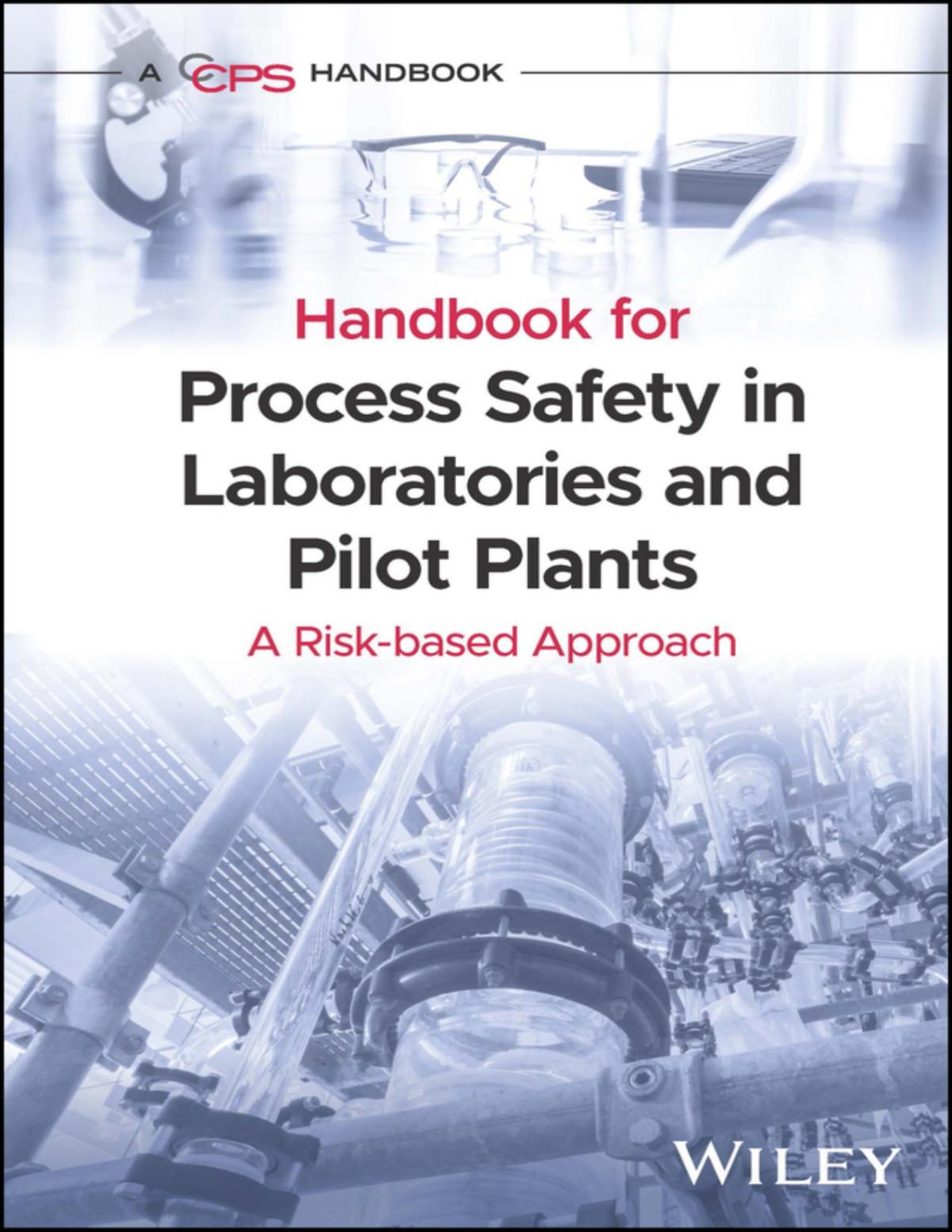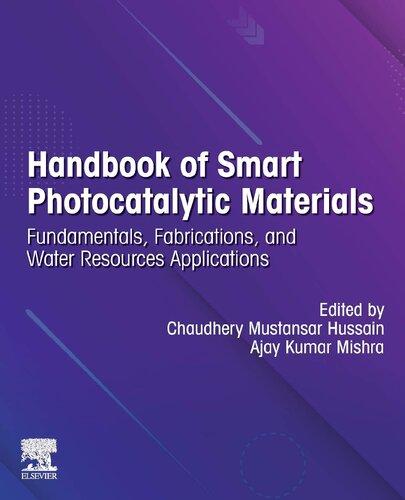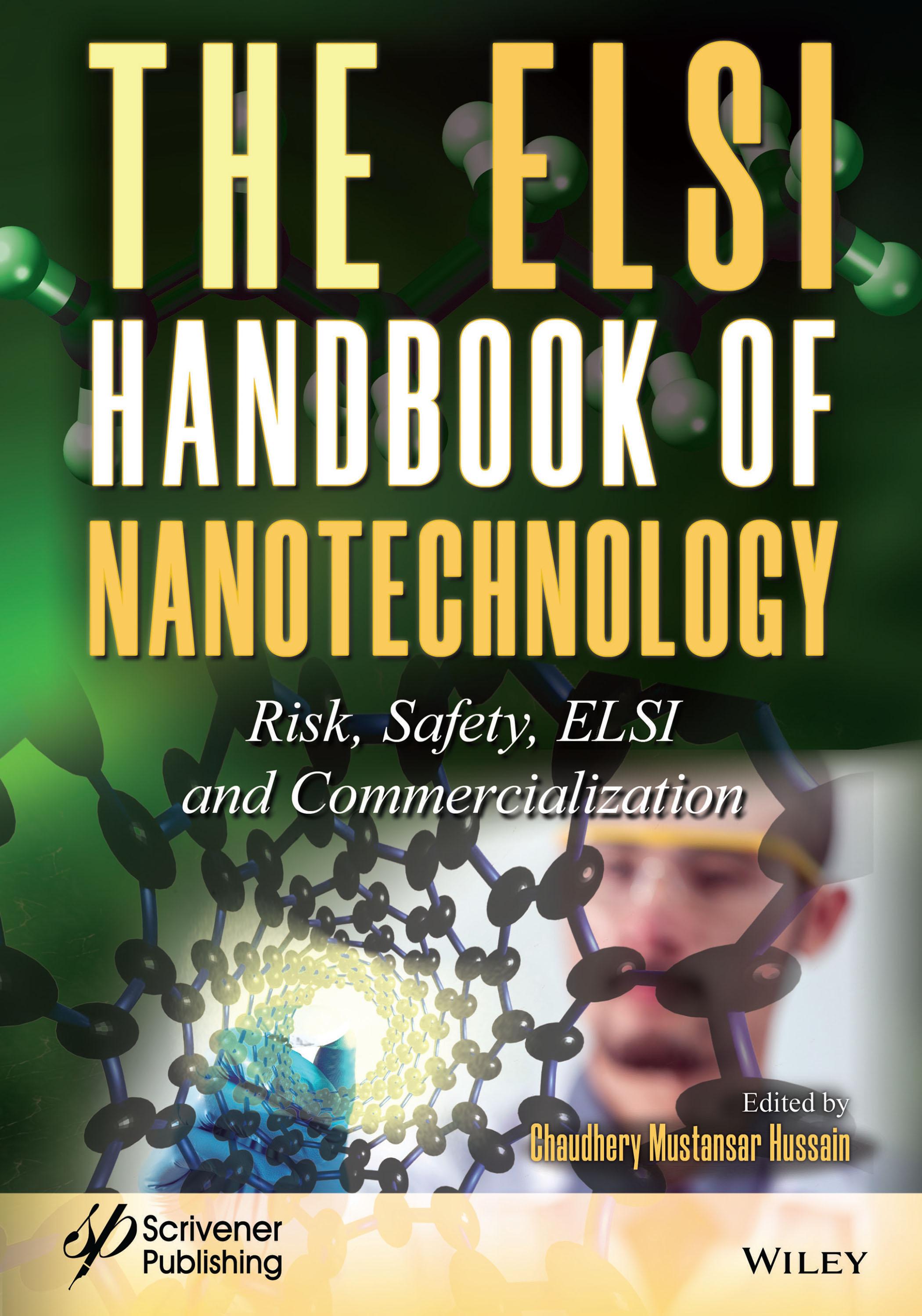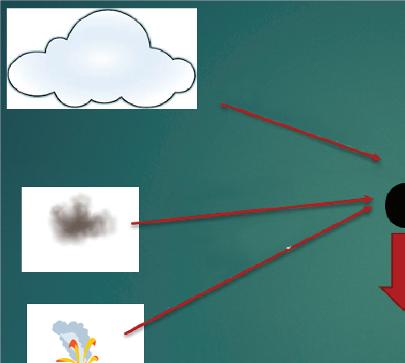The ELSI Handbook of Nanotechnology
Risk, Safety, ELSI and Commercialization
Edited by Chaudhery Mustansar Hussain Department of Chemistry and Environmental Science,
New Jersey Institute of Technology, Newark, N J.,USA
This edition first published 2020 by John Wiley & Sons, Inc., 111 River Street, Hoboken, NJ 07030, USA and Scrivener Publishing LLC, 100 Cummings Center, Suite 541J, Beverly, MA 01915, USA
© 2020 Scrivener Publishing LLC
For more information about Scrivener publications please visit www.scrivenerpublishing.com.
All rights reserved. No part of this publication may be reproduced, stored in a retrieval system, or transmitted, in any form or by any means, electronic, mechanical, photocopying, recording, or otherwise, except as permitted by law. Advice on how to obtain permission to reuse material from this title is available at http://www.wiley.com/go/permissions.
Wiley Global Headquarters
111 River Street, Hoboken, NJ 07030, USA
For details of our global editorial offices, customer services, and more information about Wiley prod-ucts visit us at www. wiley.com.
Limit of Liability/Disclaimer of Warranty
While the publisher and authors have used their best efforts in preparing this work, they make no representations or warranties with respect to the accuracy or completeness of the contents of this work and specifically disclaim all warranties, including without limitation any implied warranties of merchant-ability or fitness for a particular purpose. No warranty may be created or extended by sales representatives, written sales materials, or promotional statements for this work. The fact that an organization, website, or product is referred to in this work as a citation and/or potential source of further information does not mean that the publisher and authors endorse the information or services the organization, website, or product may provide or recommendations it may make. This work is sold with the understanding that the publisher is not engaged in rendering professional services. The advice and strategies contained herein may not be suitable for your situation. You should consult with a specialist where appropriate. Neither the publisher nor authors shall be liable for any loss of profit or any other commercial damages, including but not limited to special, incidental, consequential, or other damages. Further, readers should be aware that websites listed in this work may have changed or disappeared between when this work was written and when it is read.
Library of Congress Cataloging-in-Publication Data
ISBN 978-1-119-59160-3
Cover image: Pixabay.Com
Cover design by Russell Richardson
Set in size of 11pt and Minion Pro by Manila Typesetting Company, Makati, Philippines Printed in the USA
10 9 8 7 6 5 4 3 2 1
5.6
5.9
5.10
6.2
6.3
7.3
7.4
7.4.1.1
7.4.1.3
7.4.1.4
7.4.1.5
7.4.1.6
7.5
7.8
7.8.2
7.8.3
7.8.4
7.9
(CPC)
8.1 What is Nano-Sized Particle or Nanoparticle?
8.1.1 Classification and Wide Applications of Nanoparticles
8.1.1.1 Classification of
8.1.1.2
8.1.1.4 Classification of Nanoparticles According to Their Size/Shape/Morphology
8.1.2
8.1.3
8.1.3.1
8.1.3.3 Composition of the Nanoparticle
8.1.3.4 Surface Charge of the Nanoparticle
8.2 Interaction of Nanoparticle with Living System: Its Effects and Mechanism
8.2.1
8.2.2
8.2.3
8.2.4 Probable Mechanism for Toxicity of Nanoparticle
8.3 Toxicological Study of Different Nanoparticles
8.3.1 Effect of Silver Nanoparticles (AgNPs)
8.3.2 Effect of Gold Nanoparticles (AuNPs)
9.1
9.2
9.5
12.6
12.3.2
12.8
12.5.3
12.5.4
12.8.1
13.5
14.4
15.5
Preface
Nanotechnology is moving out of its relaxation phase of scientific route. As new products go to market and nationwide and worldwide organizations press for more public involvement in discussions of nano-related issues due to health and environmental concerns, several sectors of the public are beginning to debate the issues in hopes of settling disputes. Nongovernmental organizations have long since reacted; however, now the social sciences have begun to study the cultural portent of Nano, therefore extending discourses and opening it up to complete new social magnitudes. Social magnitudes and their newly constructed conceptions about Nano interconnect with the economy, ecology, health, governance, and deceptive prospects. Therefore, there is always the desire to be more than just an ELSI (Ethical, Legal and Social Implications) sideshow within Nano. The joint public prospects of Nano include knots of science and scientific fiction, regional enterprise, and universal alteration, all looking forward toward a sustainable future, just like past discussions about science and nature. Nano is already very much implanted in the societal stuff of our life and times. This handbook addresses these new challenges of Nano in detail with up-to-date knowledge on Safety Risks and ELSI nanotechnology.
Nano has recently evolved into a revolutionary discipline of synthesizing materials at atomic scale and nanoproducts are being used in several applications — from cosmetics to clothing, plastics to photonics, and drugs to food and energy. The economic value of Nano is measured in terms of employment, education, research activity, and commercialization of products and processes. These metrics can vary widely, therefore, it is difficult to define the base metrics of Nano. Patents, published articles and papers provide a useful metric, along with research projects and outputs, to gauge the value of academic activity. The benefits of incorporating nanomaterials in industrial scale products and processes is bringing new trials concerning environmental, health and safety risks, ethical and social issues, as well as uncertainty concerning market and consumer acceptance. Therefore, there is a need to establish relationships between Nano opportunities and Nano applications, as well as to critically analyze their concrete challenges, especially related to the impact that they may have on the health and safety of workers involved in this advanced sector. The target of this handbook is to deliver a comprehensive and easy to read text for anyone working in the Safety Risk, ELSI and Commercialization of the Nano arena and to provide essential information to consultants and policymakers about Nano applications and processes helpful in their evaluation and decision-making procedures.
College and university graduates and post-graduate students taking advance level of Nano science and technology courses will find this handbook highly up to date, easy to use and understandable. This handbook will satisfy their thirst for knowledge about Safety Risks, ELSI & Commercialization of Nano. Therefore, this handbook is mainly aimed at
advance degree level of students in nanoscience and nanoengineering. The editor and contributors are renowned researchers, scientists and true professionals from academia and industry. On behalf of Scrivener Publishing LLC., we are very obliged to contributors of all chapters for their delightful and remarkable efforts in compiling this handbook. Special thanks to Martin D. Scrivener, President at Scrivener Publishing LLC., for his enthusiastic care and dedicated help during this project. Finally, special thanks to Scrivener Publishing LLC, for publishing the handbook.
Chaudhery Mustansar Hussain, Ph.D
January 2020
Nanomaterials and the Environment
Shivani Rastogi, Gaurav Sharma and Balasubramanian Kandasubramanian*
Nano Surface Texturing Lab, Department of Metallurgical and Materials Engineering, DIAT (DU), Ministry of Defence, Girinagar, Pune, India
Abstract
Nanomaterials (NM) possess unique mechanical, electrical, catalytic, anti-microbial and optical properties owing to their dimensional constraints and have been utilized since time immemorial. With advancement in technology, environmental opportunities like augmenting resource efficiency and controlling pollution and purification of natural resources like water and air have been pivotal in the development of NMs. Metallic and non-metallic NMs along with composite variations have been devised for ecological betterment, and their efficacy in the eradication of a plethora of air and water contaminants of organic as well as inorganic origins is inevitable. The NM engineered nano-dimension materials designed specifically for eco-conservational purposes comprise materials in membranous forms, embedded structures with NMs, etc., or composites that have adsorptive, oxidative or catalytic properties for degradation of pollutants which are deemed toxic when present in water bodies, soil contaminants and air foulers. The NMs generated in controlled environments are effectively utilized for several pollutant sequestering techniques but by-products of industrial usage and automobile expulsions are considered detrimental, posing a threat to the 55 billion Nanomaterial industry (estimated market share by 2022 by CAGR). Therefore, it is imperative to maintain an ecological balance and enhance the positive effects of nano-scalar materials on the environment.
Keywords: Eco-friendly, nanocomposites, purification, photocatalysis, oxidation, adsorption, nanoparticles
1.1 Introduction
1.1.1 Overview of Nanomaterials
Nanomaterials are the chemical substances having at least one dimension in the range of nanometers (10-9m). According to ISO/TS 8004 [1], nanomaterial is defined as a “material with any of its proportion in the nanoscale range or having internal surface area in the nanoscale,” with nanoscale defined as the “length range approximately from 1 nm to
*Corresponding author: meetkbs@gmail.com
Chaudhery Mustansar Hussain (ed.) The ELSI Handbook of Nanotechnology: Risk, Safety, ELSI and Commercialization, (1–24) © 2020 Scrivener Publishing LLC
100 nm” [1]. Nanomaterials are not new to this world as there are many instances from medieval history in which nanomaterials were used during that period, i.e., Sabres from Damascus [2], now in Syria, before 900 AD, that were hard and sharp, made from a wootz type of steel. One more example of nanomaterials from history is their use by medieval stained-glass artisans. They were the first nanotechnologists and confined the nanoparticles inside a glass matrix to produce the ruby red color in the windows. Nanomaterials are designed to exhibit new and unique characteristics in comparison to the same material without nanoscale characteristics, such as enhanced strength, chemical reactivity or conductivity, etc. There are many naturally occurring nanomaterials (e.g., volcanic lava ash, ocean spray, or even biological matter like capsid, virus, etc.) and some are produced accidentally as the side products of various combustion processes (e.g., automobile engines, gas and carbon welding). Recently, researchers have been exploring various nanomaterial functionalized materials like nanofibers, beads, membranes, foams, etc., typically based on polymeric materials for environmental and water treatment applications [3–43]. On the other side, there is an extended range of nanoparticles that are engineered by physical and chemical processes for specific or targeted work and research, i.e., carbon black and titanium dioxide nanoparticles. Nanomaterials can be generally classified into two categories, as shown in Figure 1.1:
► Natural Nanoparticles: This type of nanomaterial produced in nature is due to the bio-processes, as illustrated in Figure 1.2. Due to biological decaying and chemical weathering processes, a large number of environmental colloids can occur in the environment. These colloidal nanoparticles are basic oxides and oxyhydroxides of iron (Fe), manganese (Mn), aluminium and aluminosilicates. Some nanoparticles are produced accidentally in nature due to various human activities like burning of fire, running a motor car, washing clothes, rubbing papers, etc., but the use of these nanoparticles is not significant due to their uncontrolled generation.
► Synthetic Nanoparticles: These types of nanoparticles, which are designed for a specific purpose with research by physical and chemical processes and by using different experimental techniques, are also known as man-made nanomaterials. These nanomaterials are
Figure 1.1 Types of nanomaterials [44].
Constituents
Chemical Precipitation (bottom up)
1.2 Natural processes of nanomaterials formation [45].
being produced significantly by various physical and chemical methods in R&D laboratories for commercialization and at the educational level for learning purposes. The chemistry of synthetic nanomaterials can be controlled by various means and are being used in multiple industries to make technology more advanced, less harmful and available to all for a good lifestyle and health.
Synthetic nanomaterials can be broadly classified into various categories, as shown in Table 1.1 with their types, synthesis, and examples.
Table 1.1 Types, synthesis, and examples of synthetic nanomaterials [46].
Sr. no. Nanomaterials
1. Metal NMs
Synthesis methods
Photochemical, Electrochemical, Biochemical, Thermochemical
2. Carbon NMs Arc Discharge, Laser Ablation, Chemical Vapor Deposition
3. Metal Oxide NMs
4. Polymer NMs
5. Nanocomposites
6. Bionanomaterials
Hydrothermal, Solvothermal, Sol-Gel, Reverse micelles method, ECD
Electrochemical Polymerization
Innovative Methods (depends on the material of synthesis)
Biological Methods
Examples
Pt, Rh, Pd, Ir, Ag, Cu, Co, Ni, FeNi, Cu3 Au, CoNi, CdTe, CdSe, Zns
Cylindrical Nanotubes (SWNT, MWNT), Fullerenes
ZnO, Fe2O3, Fe3O4, MgO, BaCO3, BaSO4, TiO2
Nanowires of polypyrrole, polyaniline, PAMAM
CNT epoxy composites, fluoropolymers, etc.
Viruses, Plasmids and Protein NPs
Figure
1.1.2 Overview of Environmental Health
The World Health Organization (WHO) states that environmental health denotes all the physical, chemical, as well as biological factors superficial to a person, and all the related components affecting behaviors. It circumscribes the study and ordered control of those environmental elements that are possibly harmful to health. It is focused on safeguarding against disease and creating health-supportive environments [47]. This definition excludes behavior not associated with the environment, as well as the action linked with social and cultural background and genetics. In simpler terms, environmental health concerns maintaining clean air and water, and keeping your food and the land around you safe, clean, and enjoyable, as illustrated in Figure 1.3.
The increasing effect of greenhouse gases has led to a severe issue of global warming due to which the environment is facing perils like seasonal shift, melting of glaciers, and a rise in overall air and ocean temperature. Due to global warming the lives of plants and animals are being highly impacted. To prevent the increasing effect of global warming, some human actions like burning of fossil fuels, deforestation, excessive vehicular uses, use of plastics, etc., need to be controlled.
Greenhouse gases confine heat and make the earth warmer. Various human activities are also responsible for this situation occurring. In the world, the United States is a monstrous source of greenhouse gas emission due to burning fossil fuels for heat, electricity, and transportation. In 2017 the levels of CO2 concentration in the US decreased as compared to 2016 due to the transfer of coal energy to natural gases, renewable sources of energy, etc. (see Figures 1.4 and 1.5).
1.1.2.1 Use of NMs in Environmental Health (Nanoremediation)
Nanoremediation is the application of nanomaterials for environmental remediation. The nanomaterials are used to treat groundwater, polluted air, sediments, soil, and other contaminated materials. For example, titanium dioxide (TiO2) is a good candidate for wastewater treatment. When TiO2 is exposed to sunlight, it produces hydroxyl radicals which
Figure 1.3 Components of environmental health [48].
are supremely reactive and can oxidize the environmental contaminants. Nanomaterials are widely used in various environmental applications (Figure 1.6) with a good success rate in cleaning up oil spills, water disinfectant, air pollution control, and much more. Thus, nanomaterials have given rise to a new technology for the purpose of creating a healthy environment, that is, green nanotechnology [51]. It is defined as the science and technology used to introduce nanoparticles into the environment with safe and pre-measured harmful effects. Its consideration for making nanoparticles is to create them without the use of toxic elements, at a narrow temperature, renewable inputs, and by using life-cycle processes. Nanoremediation is the application of nanomaterials for ecological remediation. It is being used to treat wastewater, soil, and, various other environmental contaminants.
Figure 1.4 Emission of greenhouse gases in 2017 [49].
Figure 1.5 Sources of greenhouse gases in 2017 [50].
Among all of these, it is most widely used in treating groundwater. During the process, a selected nanoparticle is brought into contact with the large scale of environmental contaminants which were detoxified due to the remediation properties of particles. It follows a mechanism to treat groundwater. It is known that the tiny size of nanoparticles exhibits unique attributes that may intensify remediation. They are extremely reactive due to their large surface area per unit mass. Their tiny size allows them to enter soil pores not possible by a massive size particle, giving them access to the contaminants sorbed inside the soil particles. Their movement is determined by Brownian motion rather than gravity due to their tiny size. Thus, the flow of groundwater is adequate to carry them. Then, they can remain suspended to provide in-situ water treatment.
1.2 Applications of Nanomaterials for Environment
A series of nanomaterials offer a variety of applications to revamp environment health for better living of earth creatures. These applications, such as detection of environmental contaminants (nanosensors), air and water pollutants treatment (nanofilters), land waste degradation (TiO2 nanoparticles on LDPE) [53], energy storage (solar cells), etc., have already been widely adopted on industrial levels. These applications are briefly described below.
1.2.1 Nanomaterials for Detection of Environmental Contaminants
Nanomaterials act as good adsorbents, catalysts, and sensors because of their enormous specific surface area and high surface reactivity [54]. These nanosensors (nanomaterials and their composite with polymers) have been extensively used in industries for the detection of several contaminants, including harmful gases, metal contaminants, organic as well as inorganic contaminants, and biological substances. Generally, the nanotechnologyenabled sensor consists of three main parts, i.e., a nanomaterial (e.g., quantum dots, metal nanoparticles), a recognition element (antibodies, aptamers) to provide specificity to the analyte, and a transducer system which tells the presence of an analyte in the form of a colorimetric, optical or electrochemical response [55]. There are many harmful gases present
Micelles
Dendrimers
TiO2 Nanopar ticles
Nano Sponge
Nano Sieve
Nanomembranes
Nanomaterials for Remediation
Nanotubes
Figure 1.6 Nanomaterials used in the remediation processes [52].
Table 1.2 Different nanomaterials in detection of various analytes [55, 80].
Sr. no.
NMs in environmental applications
1. SWCNT-Sn/SnO2 Nanocomposite
2. ZnO Nanowires/Reduced Graphene Oxide
3. Au Nanoparticles, Carbon or SPCEs + AuNPs, Paper
Electrodes with Carbon ink+ Carbon NMs+ AuNPs
4. WO3+Graphitic C. Composite Nitride(g-C3N4)
5. Pd NMs on C. Pasteurianum(BioNano Met)
6. Biopolymer-based carboxymethyl cellulose-stabilized Fe NPs
Detection of analyte
Ethanol Molecule
NH3
Hg (II) in water
Ethanol Gas
Methyl Orange and Evan’s Blue (azo dyes)
Cr (VI) toxicity
7. Fe Oxide and Cu Nanoparticles As(III), As(IV) ions and Pb(II) respectively
8. Chitosan/AgNPs+CuNps+CNTs Multifunctional Composites
9. Metal Doped TiO2
10. Titrate Nanotubes
Cu(II),Cd(II) and Pb(II)
Water Contaminants like 2-chlorophenol, E-Coli
Gaseous Nitric Oxide
11. SWCNT’s/QDs/Antimony NPs Cd(II) detection
in our environment which raise many serious issues like air pollution, global warming, etc. It is possible to detect such toxic gases like NO2 and NH3 through nanosensors based on carbon nanotubes by analyzing the change in electrical resistance of single-walled CNTs when exposed to these gases at room temperature [56] (Table 1.2).
Metal-oxide nanomaterials also offer functional gas sensing capabilities, e.g., titanium dioxide-based nanosensor has the potential to sense sulphur dioxide (SO2) gas, in which TiO2 nanotube array for SO2 detection is used; Figure 1.7 shows the response of different SO2 concentrations [56]. In addition to this, ZnO nanorods can sense ethanol vapors [57] and ZnO/P3HT, i.e., poly(3-hexylthiophene) hybrid nanowires, also show higher selectivity and sensitivity for ammonia [58].
In addition to the detection of harmful environmental gases, nanosensors facilitate the detection of heavy metals (mercury, cadmium, lead, chromium, etc.) present in the environment (in both air and water). The exposure of heavy metals to the human body may become a cause of severe neurological disorders. There are different types of nanostructured biosensors available for detection of heavy metals [59] (see Figure 1.8).
Figure 1.7 Linear response to SO2 exhibited by the array in a temperature range of 200 °C to 4000 °C [56].
Biosensors
Protein based
Enz ymes Purified Proteins (non- enzyme)
Inhibition assay based
Whole- cell based
Activation assay based Fusion Proteins Regulatory Proteins Monoclonal antibodies Antibodies Natural Genetically engineered
pyruvateoxidase, urease alkalinephosphatase glutaminsynthetase phytochelations, glutathione-Stransferase CueR, MerR 2A8IG5, ISB4
Bacillus sp., Photobacterium phosphoreum Escherichia coli+ , Staphylococcus aureus+ Ralstonia metallidurans
Figure 1.8 Classification of the kinds of nanobiosensors for detection of heavy metals [59].
Along with these applications, nanosensors can also detect life-threatening pathogens, e.g., contaminated water containing Vibrio cholera, a bacterium present in contaminated water which causes cholera disease via the production of cholera toxin on consumption. This detection can be achieved by using nanostructured sensor based on antibodies ganglioside GM1 (binding site of cholera toxin) or beta-galactose (a sugar with a strong affinity towards cholera toxin) modified gold nanoparticles [55].
1.2.2 Nanomaterials for Air Purification
The increasing rate of air pollution due to the exceptional living standard of people has been a severe issue and the leading cause of global warming as well. These air pollutants include smog, soot, greenhouse gases like CO2, allergens from plants, and other gases like NO2, SO2, and carbon monoxide. Such types of pollutants are detrimental to humankind. According to the reports of the World Health Organization (WHO), in 2016, 7.6% of deaths were caused due to ambient air pollution. The massive number of deaths caused by air pollution in 2016, estimated by WHO across the world, is shown in Figure 1.9.
Nanotechnology has found several ways to control air pollution. One of the solutions to air pollution includes the use of nano-adsorbents, which possess an affinity towards adsorption of a particular pollutant; for example, carbon nanomaterials act as good nanoadsorbents with CNTs that remove NOx, fullerene B40 removes CO2, and graphene oxide nanocomposites remove CO2, NH3, and SO2 [61]. The use of nano-catalysts allows the rapid and selective transformation of pollutants; for example, the photocatalytic activity of TiO2 nanoparticles is being used to create self-cleaning membranes which are successful in eliminating many contaminants, including VOCs (volatile organic compounds), nitrogen oxides and other pollutants, in less toxic material. Carbon nanotubes are also used along with TiO2 to improve its photocatalytic activity [61]. Another approach to enhance air quality offers the use of nanofilters. This approach involves the use of porous membranes having pores small enough to separate different pollutants. Metal oxide framework (MOFs) filters are found to be successful for the filtration of particulate matters (2.5 and 10) [62] (Table 1.3).
Particulate matter (PM) is an accumulation of various solid and liquid microparticles suspended in air, many of which are hazardous to living cells. Particulates are made up of numerous components, including acids, metals, chemicals and soil or dust particles [63]. They can also be formed directly by the combustion of fuel in motor vehicles and are the most harmful particulates ever known. The two particulates that are most harmful to the living cells are PM2.5 (size nearly around 2.5 microns) and PM10 (size nearly around 10 microns). Apart from their inhalation, these particulates can even penetrate the skin and enter the bloodstream and can cause several problems like cardiac arrest, cancer, skin
Figure 1.9 WHO mortality statistics of different countries in the year 2016 [60].
Table 1.3 Different nanoparticles for detection, reduction, and destruction of air contaminants [61, 62].
Sr. no.
Nanomaterials for air contaminants purification
1 Metal Organic Frameworks (MOFs)-based nanofiber filters (e.g., - ZIF-8)
2 Au@NiO core-shell nanoparticles (p-type gas sensor)
3 Cu/CuO2 nanoparticles
Air contaminant to be detected
E. coli destruction; CO2 level reduction; PM (Particulate matter) removal
Ethanol at 200 °C
Reduction of oxygen
4 Au-TiO2 NPs on silica matrix NO oxidation to nitrates and nitrites (Reducing amount of NO2 released)
5 Silicene SO2 detection
6 TiO2 coated pleated washable synthetic (PWS) fiber
Photocatalytic oxidation of VOCs and CO
disorders, blood impurity, etc. [64]. To overcome this problem, nanotechnology instigated various techniques, one of which is the use of nanomembranes which does not allow PM particles to pass through them, allowing the PMs to be collected at one end of the membrane where they can be precipitated by various electrical methods. Researchers are utilizing rotating triboelectric nanogenerator (R-TENG) to enhance a polyimide (PI) nanofiber air filter for removal of particulate matter [65]. Nowadays, electrostatic precipitation and fibrous filters are widely used to remove particulates, as these precipitators capture PMs and charge them electrically by high electric fields to precipitate them.
1.2.3 Nanomaterials for Water Treatment
Water is one of the basic requirements of all living beings on earth. Flourishing globalization and industrialization are leading causes of life-threatening pollutants and contaminants present in the water today. Primary sources of water pollution include industrial waste, household waste, oil spilling, sewage, agricultural pollution, etc. Small water pollutants, like particulate matter from industrial waste, can travel through the trachea, bronchi, alveoli and even may enter our bloodstream and cause neurological disorders, heart attack, kidney failure, etc., once consumed in high doses. Nanomaterials offer many possible solutions to the water pollution problem (see Table 1.4). Oil spilling has been a crucial issue for the marine world due to increased death rates of marine life. In nanotechnology, carbon nanotube sponges are used as an active oil sorption substance, which is as efficient as two other sorbents, i.e., polypropylene fiber fabric and woolen [66]. In addition to CNT sponges, nanoparticles, like magnetite nanoparticles and yeast-based magnetic bionanocomposites,
Table 1.4 Nanomaterials used in wastewater treatment [36, 66, 67].
Sr. no.
Nanomaterials for water treatment Applications
1. Magnetic Nanoparticles & Yeast-Based Magnetic Bionanocomposites
Oil spill cleanup
2. Lignin Nanoparticles Oil spill recovery
3. Graphene-Based Adsorbents Removal of antibiotics in aqueous solution
4. Iron Oxide Doped Halloysite Nanotubes Phosphate adsorbents
5. GO, SiO2, SnO2 Nanomaterials Zn2+ adsorbents from industrial wastewater
are also unbeaten for oil spilling treatment [67]. Nanomembranes have also been successfully used for wastewater treatment, e.g., carboxyl multiwalled carbon nanotubes/calcium alginate (CMWCNTs/CA) can successfully reject Congo red (diazo dye) in water [68]. Electrospun nanofiber membrane also serves as an emerging technology for wastewater treatment. The Electrospun nanofibers include polystyrene, polyurethanes, poly(vinyl chloride), polycarbonates, nylon 6 [68].
Despite the massive technology expansion for wastewater treatment, the first solution of water treatment is the prevention of polluted water by avoiding dumping of industrial and household wastes into the water and accepting prominent decomposition pathways of waste materials.
1.2.4 Nanomaterials for Energy Storage
Nanomaterials have the potential to enhance the conversion of environmental sources like sunlight into electricity (solar cell), thus provide solutions to the rising energy requirement on earth, which leads to an increased efficiency of several energy storage devices.
One of the several applications of nanomaterials involves the use of inexpensive porous transition metal-based nanomaterials (PTMNS), such as electrocatalysts, for energy devices like batteries, fuel cells, supercapacitors, and in water-splitting cells. These PTMNs are nanomaterials and are thriving as oxides, sulfides, phosphides, and carbides [69]. Nanotechnology-based Li-ion batteries are found to be ten times more efficient than the conventional Li-ion cells because the reduced size of the battery leads to an increase in electrical conductivity, which in turn increases the power. Nanotechnology can also solve the problem of an expensive Platinum-based catalyst by reducing it to nano size, thus, using a small amount of platinum and reducing the costing. Moreover, the nanosized platinum catalyst was found to be much more efficient with 12 times more electric current production and ten times longer lifetime than the conventional catalyst [70].

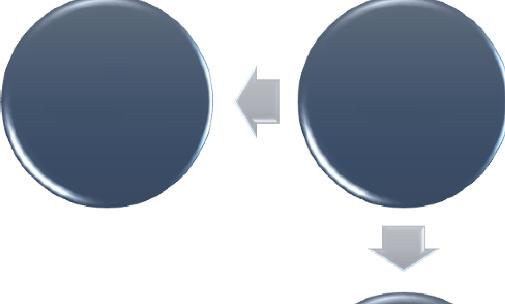



Metal nanoclusters (MNs) are another fascinating nanotechnological development in the energy sector. MNs act as an efficient catalyst in nanosized dye-sensitized solar cells (DSSCs) or quantum dots-sensitized solar cells (QDSSCs). They are also found to be successful in CO2 conversion to fuels [71]. Nanomaterials also contribute to the wind energy sector by enhancing the performance of windmills. A few examples of nanomaterials used in windmills include CNTs + epoxy used for windmill blades, which imparts light weight and strength to blades and increases generation of electricity. Another application of nanomaterials includes the use of conductive nanomaterials, which results in increased lighting production. Nano-optimized power storage devices are another example of a nanomaterial application in promoting wind energy. Nanomaterials also have significant use in solar cells. At Michigan Technological University, a group of researchers developed graphene structures in the shape of a honeycomb in which the sheets are separated by lithium carbonate. They used these graphene sheets to substitute the platinum in dye-sensitized solar cells and obtained the solar conversion efficiency of 7.8 percent [72]. However, the nanotechnology developed solar cells are not very efficient due to their cost offsets, but in future terms, this may prove to be a successful technology for the energy sector by amplifying them with the use of quantum dots [73] (Figure 1.10).
1.2.5 Nanomaterials for Degradation of Land Waste
Increasing living standards have been the cause of many serious problems; aggregation of land waste is one of those problems requiring new solutions and technology. Out of all
Nano electrocatalyst (PTMNS)
nanosized Ptbased Catalyst in Li-on Batteries
NMs in Energy Sector
Metal Nanoclusters in DSSCS and QDSSCS
CNTs & Epoxy for Windmill Blades
Figure 1.10 Use of nanomaterials in different energy sectors [69–72].




